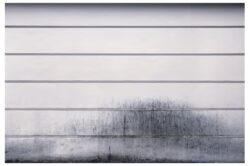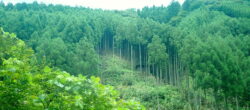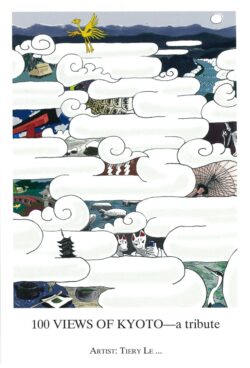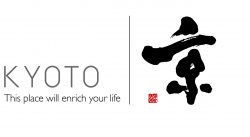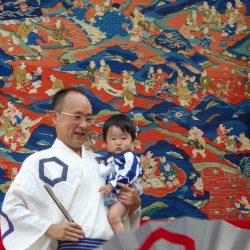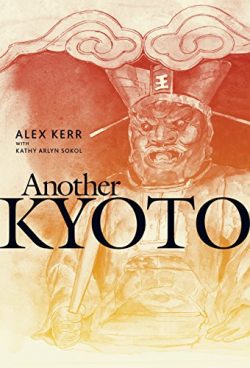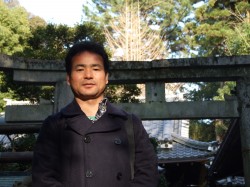Kyoto Notebook
The Great Fire of Kyoto, 1788: A Forgotten History
It was mid-afternoon on the last day of the month when fire broke out just east of the Kamo river and south of the small Donguri Bridge (south of Shijō). By 6pm flames had spread as far as Teramachi, a thoroughfare containing many temples. By midnight it was at the Shimogamo Shrine. At 2am the Dairi (today called the Gosho, or imperial palace) was threatened; shortly thereafter the main walled section of the shogunal compound, Nijō Castle, was alight. Rain fell, but it was not enough, and by morning 201 temples, 37 shrines, 36,797 common dwellings and a total of 1,424 city blocks in 20 separate locations were gone.
Read MoreCharcoal-inspired Sumi Artistry
The Kyoto-based artist known simply as Hakama uses sumi (charcoal) as his medium in creating innovative artworks with a subtle but impressive aesthetic imbued by direct use of natural materials transformed by fire.
His work was featured in KJ 107, ‘Fire & Kyoto.’
Read MoreKyoto Flame: sparking untold narratives in Kyoto
Charles Roche, long-term Kyoto resident, reminisces about The Flame, a unique monthly community-based storytelling event held at his hospitable Papa Jon’s Eatery. As figurative keeper of the flame for three years, Charles sparked a conflagration that lit up the local scene.
Read MoreMICHIKO AND THE SHUMISEN STONE
612 CE: This year a man emigrated from Baekje whose face and body were all flecked with white, perhaps having been infected with white ringworm. Disliking his extraordinary appearance, the people wished to cast him away on an island in the sea. But this man said, “If you dislike my spotted skin, you should not breed horses or cattle in this country which are spotted with white. Moreover, I have a small talent. I can make the figures of hills and mountains. If you kept me and made use of me, it would be to the advantage of the country. Why should you waste me by casting me away on an island of the sea?”
Read MoreKyotographie 2024, “Source”: Wellsprings of Creativity
For the past 13 years, co-directors Lucille Reyboz and Nakanishi Yusuke have invited the people of Kyoto – old, established families to tourists just passing through – to engage in a month-long jeu d’esprit inspired by their ecumenical embrace of all aspects of the photographic medium, from crude pinhole cameras to high-powered scientific instruments, and everything else in between.
Read MoreWhite Lines
Horizontal lines on an earthen wall. Found on the outer walls of temples, some shrines, and the Imperial Palace, these lines indicate close historical ties to the Imperial family. Some temples have three or four lines, but the walls of monzeki jiin, where members of the Imperial family have served, are decorated with five.
Throughout the city of Kyoto, these lines are so ubiquitous as to go unnoticed by visitors and residents alike. For me, they have a mysterious beauty. Amidst all the classic scenes of Kyoto, I have found myself photographing these simple walls again and again. They are images which were literally painted by the weather.
Read MoreFeeling the trees shivering: endangered environmental knowledge in northern Kyoto
For more than 400 years, villagers in the northern mountains of the Yamashiro basin (an area now incorporated to the modern administrative system of Kyoto city) have developed a special relationship with trees—in particular, with one specific type of tree, the cedar or Cryptomeria japonica, called sugi in Japanese.
Read MoreKyoto View 92: a postcard by Tiery Le,..
Readers who ordered KJ100 received various selected bonus inserts (as a way of celebrating this centennial issue); among them was a unique, specially-designed postcard by local artist and long-time KJ contributor Tiery Le,.. This view is a quirky contemporary Tiery riff on the rakuchu rakugai zu screen paintings of feudal-era Kyoto, those richly detailed bird’s-eye…
Read MoreNOTES OF A TRIP TO KYŌTO
On the back cover of KJ 100 is a short quote from the celebrated Meiji-era writer Lafcadio Hearn, describing lantern decorations he saw when visiting Kyoto (from his home in Kobe) for its 1100th anniversary celebrations in 1895. He recorded his impressions of Kyoto in a multi-part essay anthologized in his 1897 book Gleanings in…
Read MoreEXTRA!
KJ100: EXTRA! On this page we present additional views, impressions and visions of Kyoto, as an ongoing project complementing our print edition, KJ100: ‘100 Views of Kyoto – a Tribute.’ Kyoto View 18: Finding Home – Lauren W. DeutschWhen I passed a huge statue of Kannon, standing guard 24/7 by the door of one of…
Read MoreKyoto-tomason: the Hunt for Hidden Hyperart
I had been taking pictures of these strange silhouettes encountered in Kyoto for a long time without knowing what to name them. Later, I learned that what I was photographing was “hyperart-tomasons” (chôgeijutsu-tomason), and that Akasegawa Genpei (1937-2014) had been the facetious inventor of this concept that encompasses a panoply of types — some of…
Read MoreViewing the Famous Scenes of Kyōto in Meisho Zue
While physical entry to Japan by non-residents is currently prohibited, our latest issue, 100 Views of Kyoto – A Tribute, is a convenient alternative way for overseas readers to visit (or revisit) Kyoto. Cutting edge post-Covid tourism? Not really. Kyoto has in fact been a popular destination for virtual travel since way back in 1780…
Read MoreNeighbors
Two poems by Robert MacLean appear in KJ100, ‘Sweeping,’ excerpted from his new book Waking to Snow (Isobar Press, 2021) and a haiku from I Wish, a recent anthology from the Hailstone Haiku Circle. The cover of I Wish also appears—designed by wood-block artist Richard Steiner. Robert and Richard were published together in KJ 5,…
Read MoreKyoto Organic, by Kobayashi Mai
If Japan is considered a super-aged society, the agricultural population could be described as hyper-aged. However, a small but definite intergenerational shift is cause for optimism. Throughout Japan, a new wave of people from non-farming backgrounds are choosing to get their hands deep into the soil, many practicing organic agriculture. “Organic” is a legal term;…
Read MoreFinding Home
Lauren Deutsch finally found her long-lost slide of the shopfront she describes in Kyoto View 18, ‘Finding Home’ — after KJ100 went to the printer. So, we’re posting her reminiscence again here, together with the photo. The MIPPW—Most Important Piece of Paper in the World—was a hand-drawn map of a neighborhood in north-east quadrant of…
Read MoreA Definitive Ranking of the Ducks of Kamogawa
We’ve taken the liberty of identifying the most common species of duck inhabitants on the Kamo River, and ranking them from ugliest little duckling, to virtual bird of paradise.
Read MoreThe Kyoto City KYOCERA Museum of Art
After three years of much-needed renovation, the large Neoclassical building (with a “Japonesque” roof) located across the street from the Museum of Modern Art Kyoto, next to the Heian Shrine Otori, is re-opening as the Kyoto City KYOCERA Museum of Art on May 7th, 2020.
Read MoreKyoto City relaunches kyoto.travel, the definitive guide for foreign visitors to the old capital
If you have ever connected to the Kyoto WIFI network at one of the more than 1,000 access points around the city, you will be familiar by now with the Kyoto Official Travel Guide at kyoto.travel, which is the first page to pop up on your screen. Now, Kyoto City has launched a highly anticipated…
Read MoreKyoto’s Gion Festival: Warding Off Epidemics for 1,150 Years
Thanks to their treasures, the Gion Festival floats have been famously referred to as “Moving Museums.” Like any museum, to stay vibrant the Gion Festival requires a quest, an investigation. Otherwise they risk becoming morgues of artifacts, meaningless to most people.
Read MoreDream Landscapes in 3D: An excerpt from Another Kyoto by Alex Kerr
Another Kyoto is a “spoken” book which resulted from conversations between Alex and Kathy Arlyn Sokol as they explored temples and gardens over the years.
Read MoreExiled – A Tibetan’s Tale
“I was concerned about the many differences between India and China — the ways of thinking, for one — and India was not really up to confronting China. If I stayed in India, maybe I wouldn’t be able to do the kind of things I really wanted to do to help Tibet.” He eventually set his sights on Japan, with its own brand of Buddhism and spirituality, as his next home in exile.
Read More





